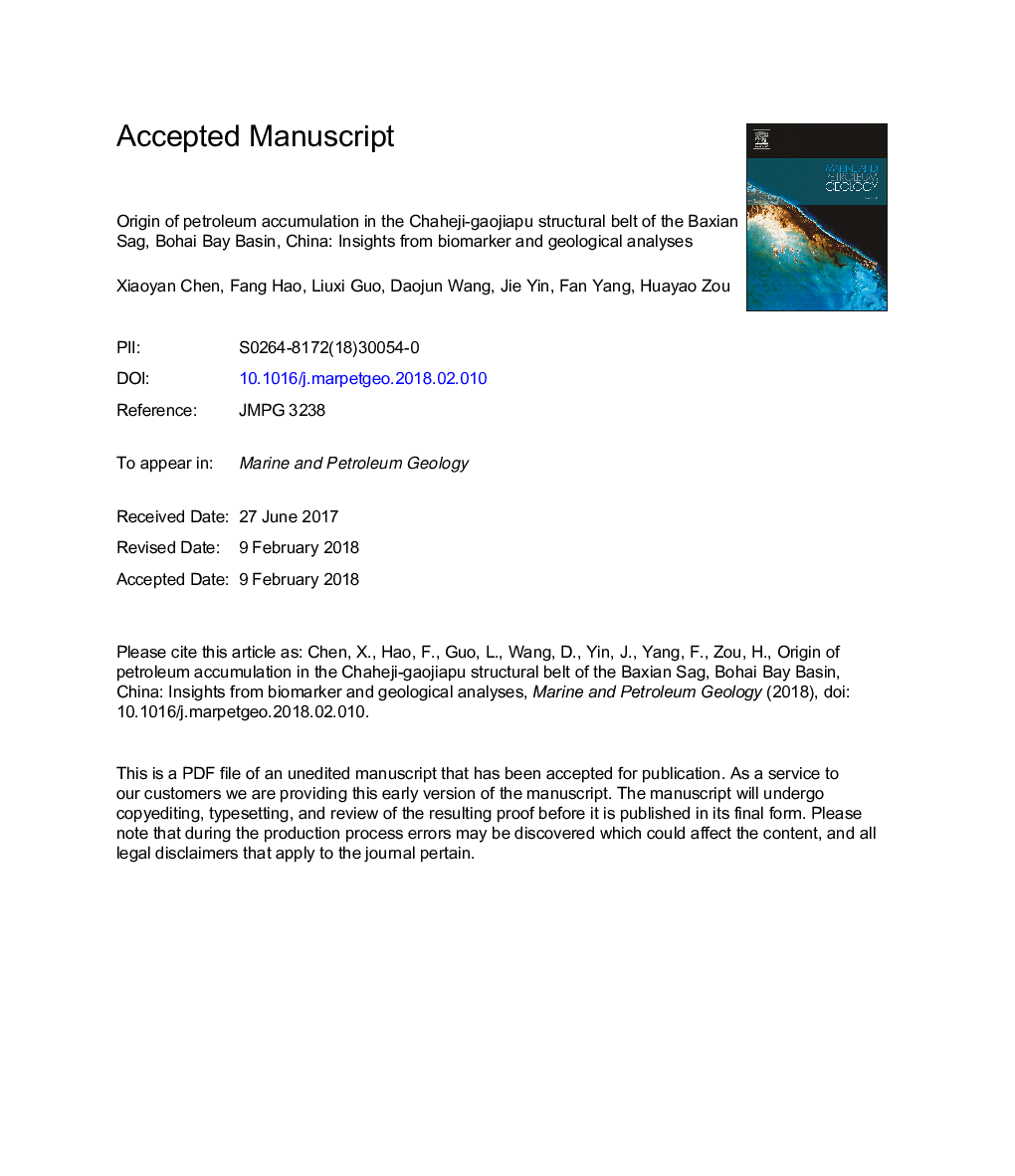| کد مقاله | کد نشریه | سال انتشار | مقاله انگلیسی | نسخه تمام متن |
|---|---|---|---|---|
| 8909069 | 1637132 | 2018 | 39 صفحه PDF | دانلود رایگان |
عنوان انگلیسی مقاله ISI
Origin of petroleum accumulation in the Chaheji-gaojiapu structural belt of the Baxian Sag, Bohai Bay Basin, China: Insights from biomarker and geological analyses
ترجمه فارسی عنوان
منشاء انباشت نفت در کمربند ساختاری چاهجی گاجیاپو ساچمه باکسین، حوضه خلیج بوخای چینی: بینش از بیومارکر و تجزیه و تحلیل زمین شناسی
دانلود مقاله + سفارش ترجمه
دانلود مقاله ISI انگلیسی
رایگان برای ایرانیان
کلمات کلیدی
موضوعات مرتبط
مهندسی و علوم پایه
علوم زمین و سیارات
زمین شناسی اقتصادی
چکیده انگلیسی
The origin of petroleum accumulations in the Chaheji-gaojiapu structural belt of the Baxian Sag, Bohai Bay Basin was evaluated based on the results of Rock-Eval pyrolysis on 135 samples and a biomarker analysis on 26 source rock samples and 33 oil samples. The four possible source rock intervals have different biomarker assemblages and were deposited in different environments. For example, pristane/phytane, C27-diasterane/C27-sterane and C19/C23-tricyclic terpane ratios show an increasing trend, but (C28+C29)-tricyclic terpane/[(C28+C29)-tricyclic terpane + Ts] and steranes/hopanes parameters display a decreasing trend among the lower part of the first member (Es1L) and the middle (Es3M) and lower part (Es3L) of the third member of the Eocene Shahejie Formation. This finding indicates that a decreasing anoxic and alkaline environment with an increasing input of terrigenous organic matter developed during the deposition of the Es1L, Es3M and Es3L source rocks. However, the biomarker parameters of the forth member (Es4) of the Eocene Shahejie Formation display highly similar characteristics with the Es3L source rocks, except for the C29-sterane 20S/(20S + 20R) and C27-diasterane/C27-sterane ratios, which show obviously higher than the other source rock values. The Es3-derived oils are absolutely dominant in the Chaheji-gaojipu structural belt, based on the biomarker analysis of saturated hydrocarbon, with slight or no contributions from the Es1L and Es4 source rocks because of the low maturation for the Es1L source rock and the absence of vertical migrating channels for the Es4 source rock. Faults are vital to petroleum migration and accumulation in this area and demonstrate the following double effects: (1) the deep faults cutting off the Es3 source rocks are the key channels for oil vertical migration; (2) the shallow faults entrap oil and finally form the commercial oil pools. As a result, the fault block reservoir is the major oil-reservoir type in the Chaheji-gaojiapu structural zone, and the lithologic reservoir is another oil-reservoir type in this area. Based on 1D burial and thermal history modelling, the E3 and E4 source rocks reached the oil-generation peak at approximately 5 Ma and 20 Ma, respectively, but the Es1L source rock is still in the low-mature stage. Therefore, the process of the large oil migration and accumulation for the Es3 source rocks occurred during the late Neogene-Quaternary. Through this research, there are two considerable exploration potentials for this area, including condensate reservoirs in the deep strata and low-mature reservoirs in the Es1 stratum interval.
ناشر
Database: Elsevier - ScienceDirect (ساینس دایرکت)
Journal: Marine and Petroleum Geology - Volume 93, May 2018, Pages 1-13
Journal: Marine and Petroleum Geology - Volume 93, May 2018, Pages 1-13
نویسندگان
Xiaoyan Chen, Fang Hao, Liuxi Guo, Daojun Wang, Jie Yin, Fan Yang, Huayao Zou,
